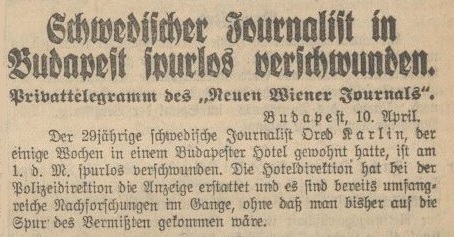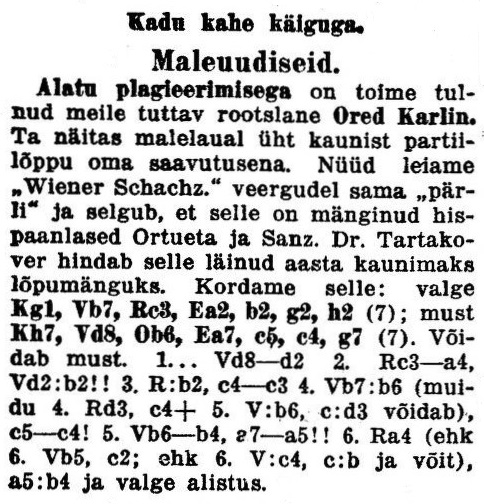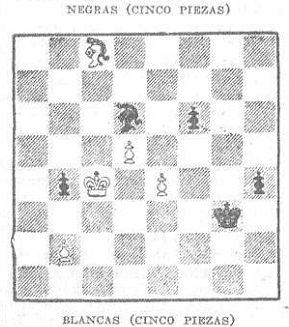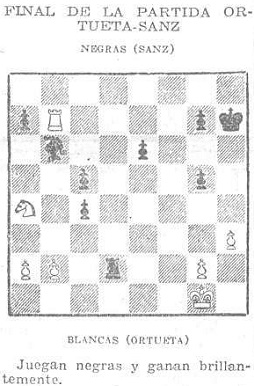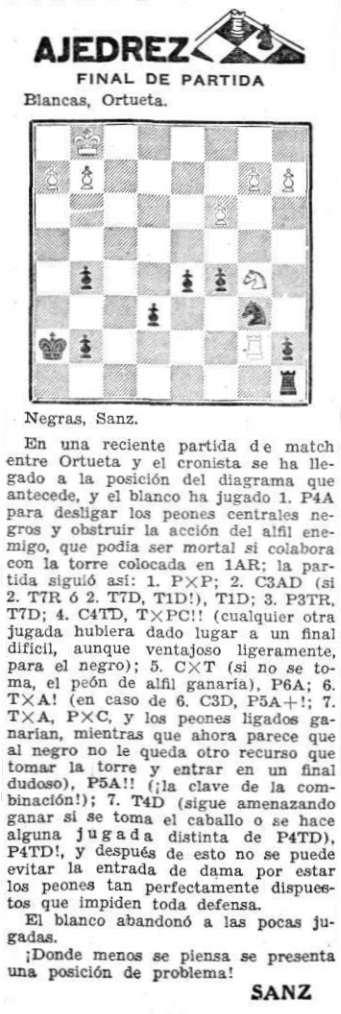Chess Notes
Edward Winter
When contacting us by e-mail, correspondents are asked to include their name and full postal address and, when providing information, to quote exact book and magazine sources. The word ‘chess’ needs to appear in the subject-line or in the message itself.
| First column | << previous | Archives [164] | next >> | Current column |
10750. Fischer and women
On the topic of Chess and Women and, in particular, Bobby Fischer’s views (C.N.s 9218 and 9253), Olimpiu G. Urcan (Singapore) notes a remarkable interview with Fischer (Canadian Broadcasting Corporation).
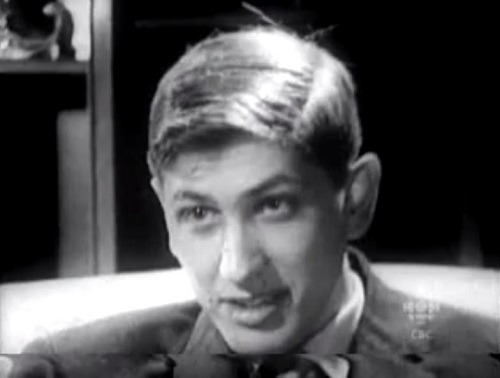
10751. Tempi
Wanted: early sightings of the rule-of-thumb suggestion about the material value of three tempi. Examples from the 1930s:
- Tarrasch:
‘Ebenso kann man einen Bauern gleich drei Tempi schätzen.’ Page 311 of Das Schachspiel (Berlin, 1931). From page 219 of The Game of Chess (London, 1935): ‘A pawn can be valued at three tempi.’
- Spielmann:
‘Wir wissen, daß in offener Stellung drei Tempi ungefähr einen Bauer ersetzen.’ Page 45 of Richtig Opfern! (Leipzig, 1935). From page 93 of The Art of Sacrifice in Chess (London, 1935): ‘We know that in an open position three tempi are approximately equal to a pawn.’ From page 85 of the Reinfeld/Horowitz revision (New York, 1951) of J. du Mont’s translation: ‘We know that in open positions, three tempi are approximately worth a pawn.’ Although the volume by Reinfeld and Horowitz was an extensive rewrite, it was used in the ‘21st Century Edition’ (Milford, 2015) without any mention of them.
10752. Grünfeld and Gereben
The remark by Spielmann about tempi quoted in the previous item came from his annotations to a game which he won at Sopron, 1934:
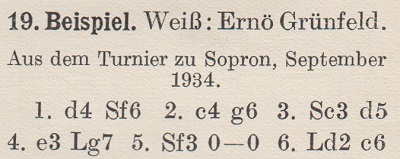
Original edition of Richtig
Opfern! by Spielmann (1935), page 44
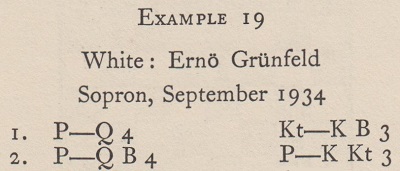
Translation by du Mont
(1935), page 91

Extensively
revised/rewritten edition by Reinfeld and Horowitz
(1951), page 84
As is well known, Ernő/Ernst Grünfeld of Sopron (1907-88) changed his name to Ernő Gereben, and in the Spielmann game either Grünfeld or Gereben may be used, as long as no impression is given that the player was the E. Grünfeld (1893-1962). That impression was given when the game appeared, with Spielmann’s notes, on pages 224-225 of the December 1934 Chess Review ...
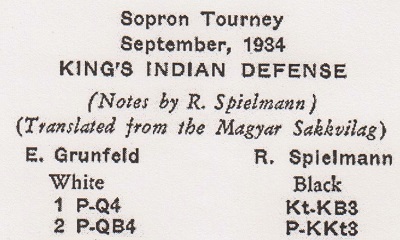
... and when Irving Chernev presented the conclusion on pages 167-168 of Combinations The Heart of Chess (New York, 1960):
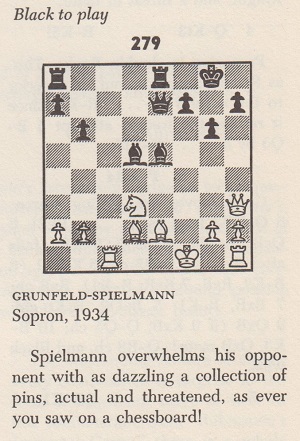
In a report on Sopron, 1934 on page 264 of the September 1934 Wiener Schachzeitung the confusion was referred to by Spielmann himself:
‘Der Soproner Meister Ernő Grünfeld hat sich wacker gehalten, darf aber nicht mit dem Wiener Großmeister Ernst Grünfeld verwechselt werden, wie dies einer Wiener Tageszeitung passiert ist.’
The most detailed account of the Grünfeld/Gereben name-change known to us is on pages 11-13 of Ernő Gereben by Gottardo Gottardi (Kecskemét, 1991).

10753. The Sunday Express
If a reader has access to December 1921 editions of the Sunday Express it will be appreciated if the reference in Test Tube Chess shown in C.N. 10700 can be looked into, given that 27 December 1921 was not a Sunday.
10754. Morphy v Paulsen, New York, 1857
In the final round of the New York, 1857 tournament, Morphy defeated Louis Paulsen +5 –1 =2. According to the Lange, Maróczy and Sergeant monographs on Morphy, the dates of the eight games were as follows: First: 29 October; Second: 30 October; Third: 2 November; Fourth: 4 November; Fifth: 6 November; Sixth: 8 November; Seventh: 8 November; Eighth: 10 November.
Hans Renette (Bierbeek, Belgium) writes:
‘My particular interest is in the dates of the concluding games between Morphy and Paulsen. The New York, 1857 tournament book is rather vague and not altogether trustworthy. On page 68 of Paul Morphy The Pride and Sorrow of Chess (New York, 1976) David Lawson stated that the sixth game was played on 3 November, and page 71 gave 6 November and 10 November as the respective dates of the seventh and eighth games. There was no explanation for the gaps in the schedule.
The New Orleans Daily Picayune of 13 November contains a quote from the New York Courier and Enquirer of 6 November which reported that the final game had been played on 5 November:
‘The chess congress was virtually brought to a close last evening by Paul Morphy winning the decisive game, the fifth, from Mr Paulsen [the eighth game is meant, i.e. Morphy’s fifth victory – H.R.]. Mr Paulsen was suffering from a severe catarrh yesterday, and might with great propriety have requested a postponement of the contest; but he fought gallantly and yielded gracefully.”
The New York Times reported on 7 November:
“At the chess congress Mr Morphy has won five games in the last section of the Grand Tournay, entitling him to the first prize.”
Which newspapers of the time allow the games to be dated precisely, beyond all doubt?’
10755. Spencer/Silberberg/Silverberg
Alan McGowan (Waterloo, Canada) draws attention to his Chess Scotland webpage on a mysterious figure, Ralph Spencer (‘formerly Rolf Silberberg’ and also named ‘Silverberg’).
Our correspondent wonders whether Ralph Spencer was the Silberberg who participated in a tournament in Paris in 1938.

Deutsche Schachzeitung, August 1938, page 234.
10756. Emanuel Lasker and draughts/checkers (C.N.s 4630 & 4662)
Alan Smith (Stockport, England) submits this game between Alfred Jordan and Emanuel Lasker from the Newcastle Morning Herald and Miners’ Advocate, 21 September 1895, page 11:
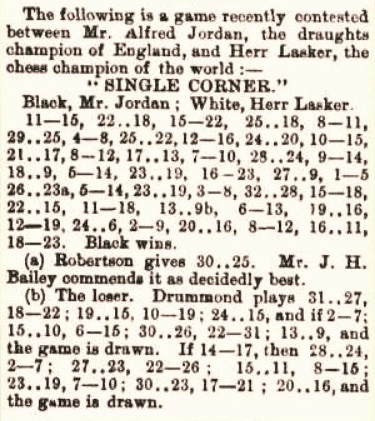
10757. Spielmann brilliancy (C.N. 10752)
Spielmann’s original text on pages 235-238 of Magyar Sakkvilág, September-October 1934 has been supplied by the Cleveland Public Library:
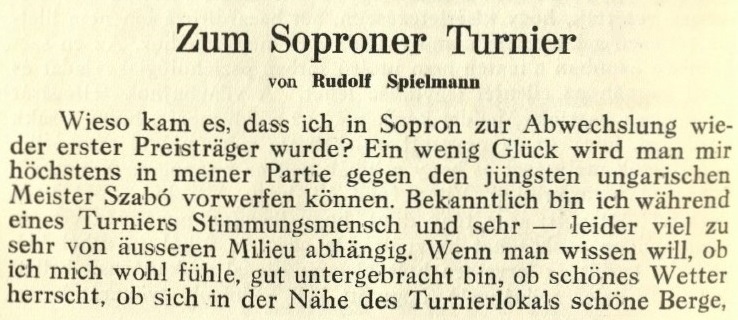
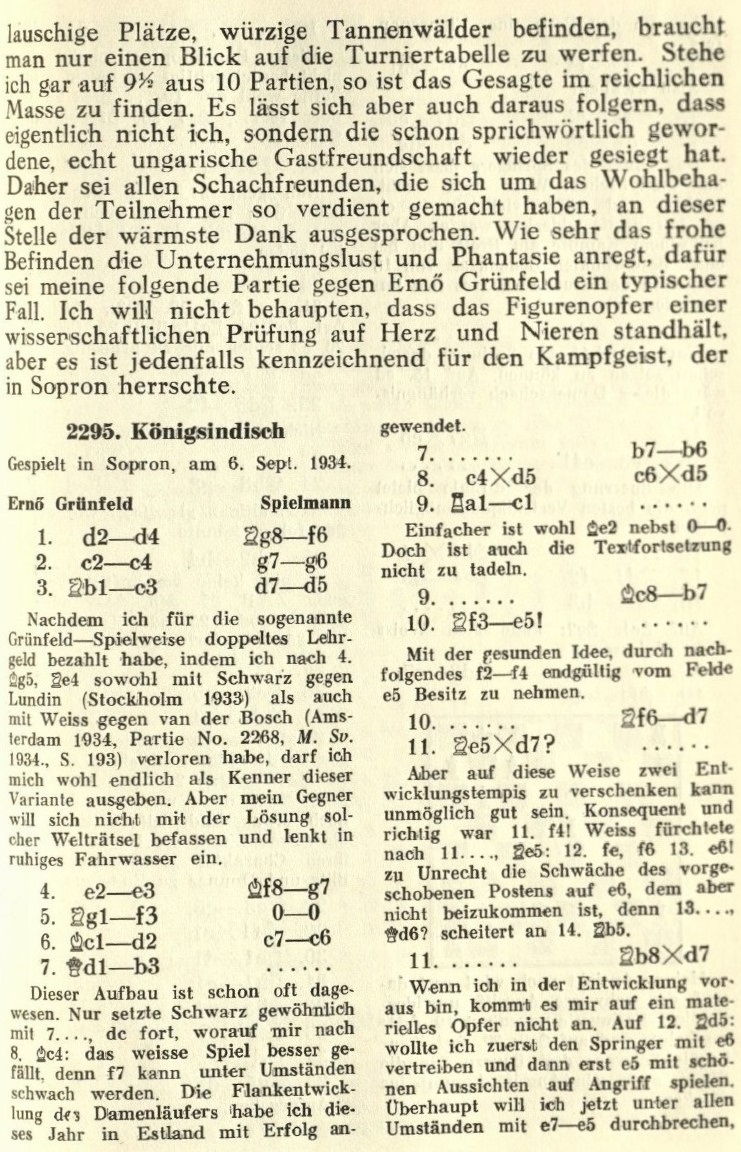
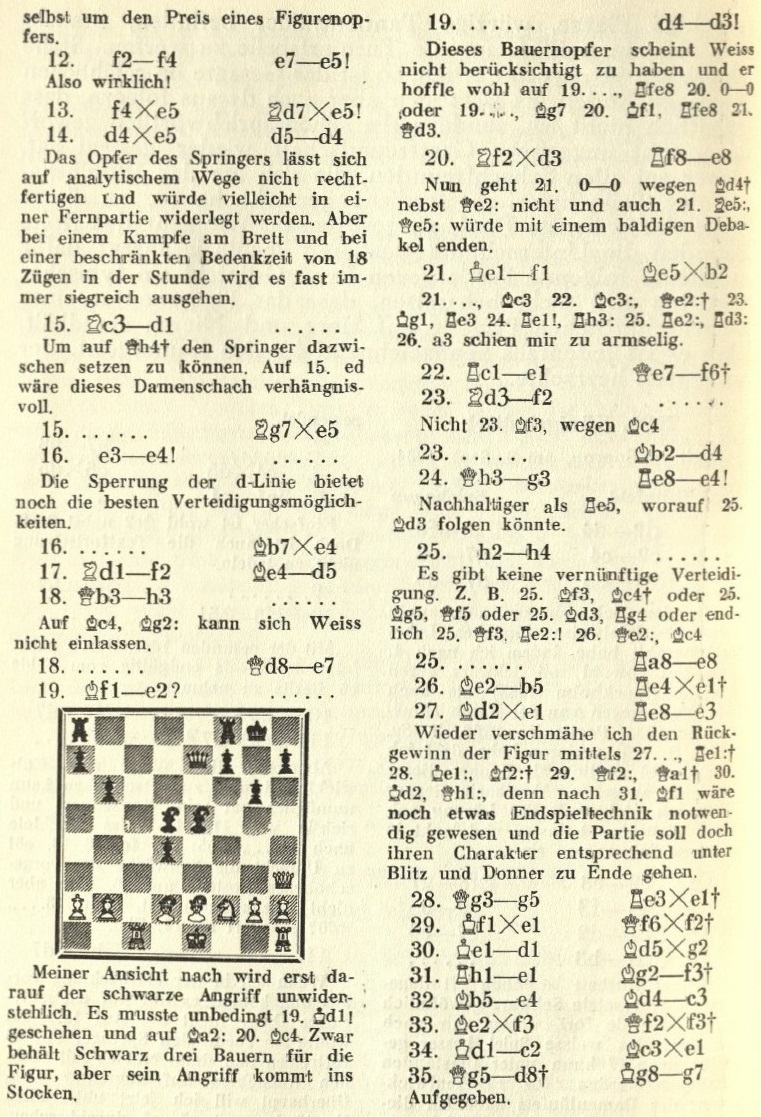
10758. Early recognition of Smyslov (C.N. 6516)
From page 104 of the November-December 1940 American Chess Bulletin, in a report on that year’s USSR championship in Moscow:
‘The play of the youthful Smyslov is of unusual profundity, originality and versatility. He invites complications and preferably selects difficult systems of defense. When opportunity offers, he is capable of giving a display of fireworks on the chessboard.’
10759. Curiosities
Page 105 of the November-December 1940 American Chess Bulletin:
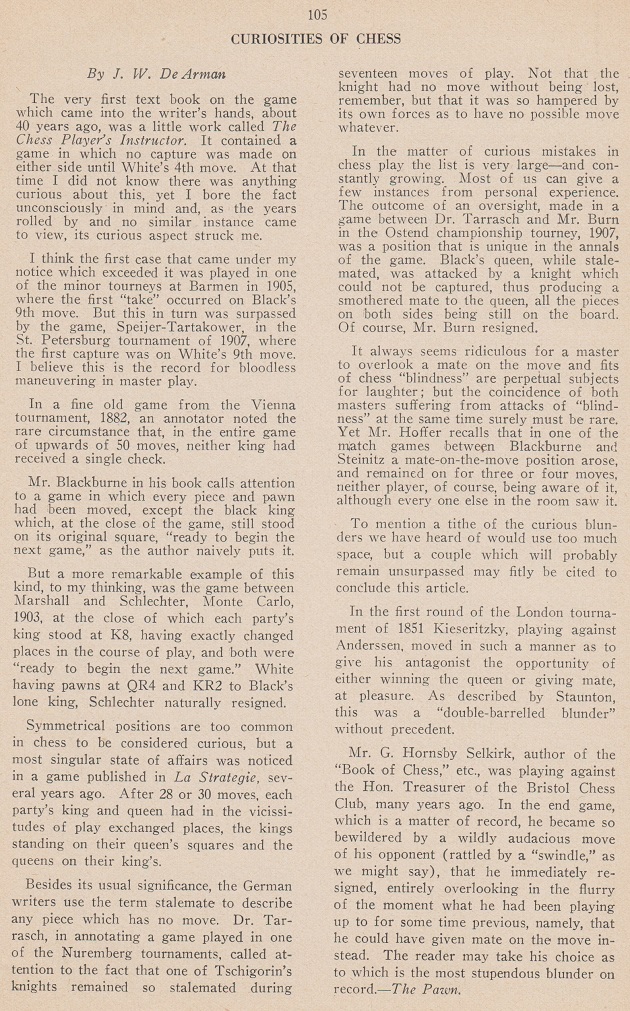
Below is the article’s appearance in The Pawn, nearly 30 years earlier (page 29 of the second volume):
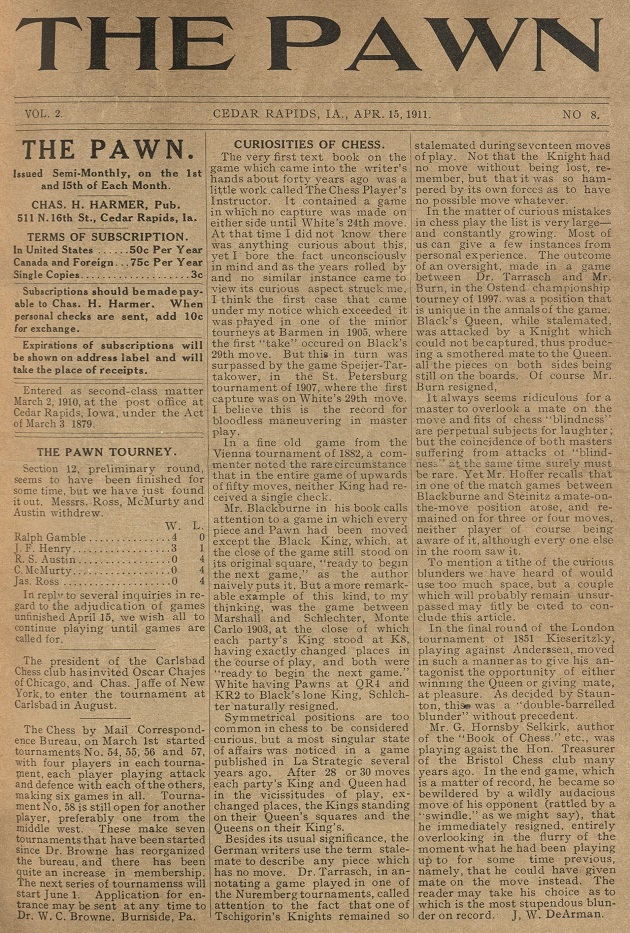
Acknowledgement for the page from The Pawn: the Cleveland Public Library. Readers will note for themselves the article’s many defects.
John W. De Arman, or DeArman, was discussed in C.N.s 7572
and 7598.
10760. Zukertort, Pillsbury and Bernstein
Jan Kalendovský (Brno, Czech Republic) provides the following illustrations:
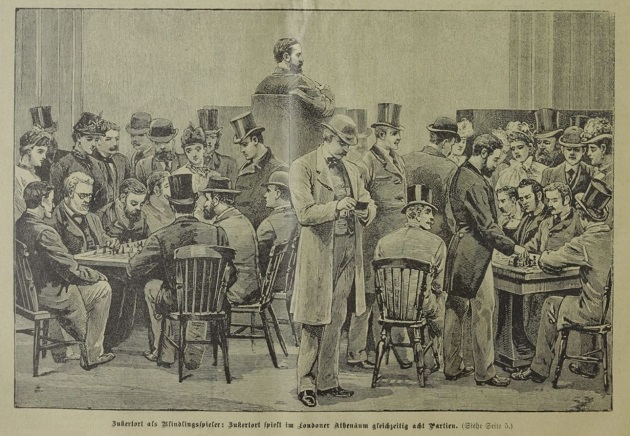
Source: Das interessante Blatt, 5 November 1885, page 6. This picture of Zukertort is a much better version of the one shown in C.N. 8514.

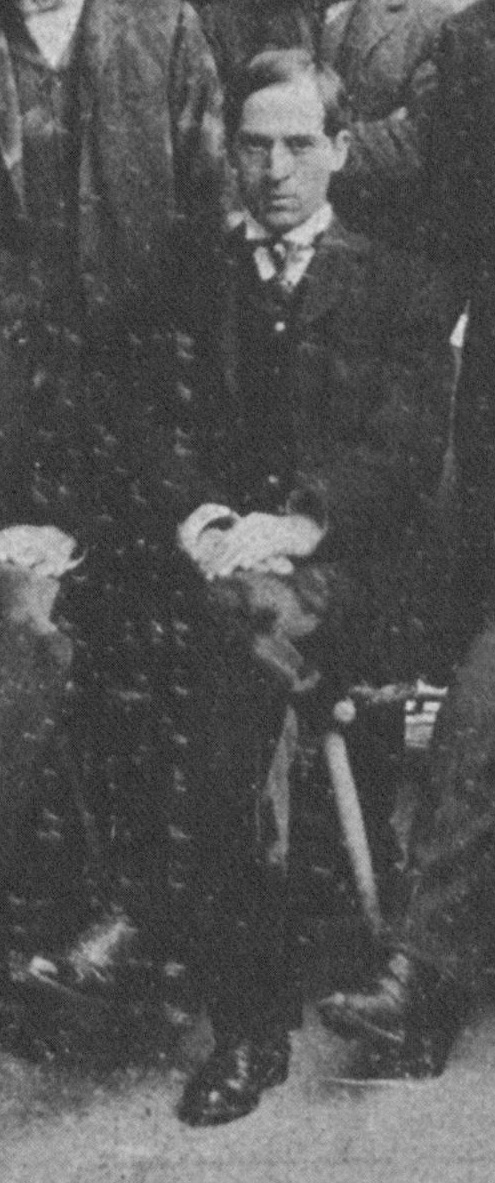
Harry Nelson Pillsbury
Source: Österreichs Illustrierte Zeitung, 28 September 1902, page 892. The website has the incorrect date 28 August 1902.
Our correspondent also draws attention to an interview with Ossip Bernstein on pages 4-5 of the Neues Wiener Journal, 3 November 1925.
10761. Emanuel Lasker and the Café Kaiserhof tournament
Richard Forster (Zurich) writes:
‘In June 1889 Emanuel Lasker won a tournament at the Café Kaiserhof in Berlin. From a biographical note in the Chess Monthly, April 1890, page 226: “His first success dates from June 1889, when he won the first prize in a tournament at the Kaiserhof, Berlin, without losing a single game.” In an interview with the Berliner Schachzeitung (the issues of 1 and 16 April 1896, pages 3-7 and 18-21) Lasker mentioned that he had won every game in a tournament organized among students at the Café Kaiserhof, that each participant paid one Thaler and that the winner was to take everything: “Um jene Zeit wurde von mehreren hiesigen Studenten ein Turnier im Café Kaiserhof veranstaltet, in der Weise, dass jeder Teilnehmer einen Thaler einzuzahlen hatte und der Sieger den ‘Pot’ gewinnen sollte. Hierbei gewann ich sämmtliche Partieen und damit den Preis.” Lasker’s victory in all the games in the Kaiserhof tournament is confirmed by a report in Deutsches Wochenschach, 8 April 1894, page 116, which mentioned that Karl Holländer came second.
Describing the success on page 20 of Emanuel Lasker Biographie eines Schachweltmeisters (Berlin, 1952) Jacques Hannak mentioned a “Winterturnier” at the Kaiserhof, in the years 1888-89. Ken Whyld, on page 14 of The Collected Games of Emanuel Lasker (Nottingham, 1998), even referred to “the annual tournament of the Kaiserhof café in Berlin, in 1888-89”. This is in contrast to the earlier reports which point to a rather shorter event, with Deutsches Wochenschach in 1894 even calling it a “preparation tournament” for the summer 1889 Breslau congress. Does any reader have more information on the event?’
10762. Lasker’s combination against von Heydebreck
Page 239 of Deutsches Wochenschach, 14 July 1889 gave this ending won by Lasker against Dr von Heydebreck at the Café Kaiserhof:

After 1...a5 2 Rd7 Rb1 White was unable to take the queen because of 3...Nf2+ 4 Nxf2 Rxg1+ 5 Kxg1 Re1 mate, and Black went on to win after 3 Rdd1 Rxd1 4 Rxd1 Nxc3.
Richard Forster comments:
‘It has been speculated by later writers that this ending was played in the 1889 Kaiserhof tournament. However, in an 1896 interview with the Berliner Schachzeitung (C.N. 10761) Lasker not only called it a tournament among students but also described Dr von Heydebreck as one of his most frequent opponents in those days at the Café Kaiserhof. The philologist Dr Wilhelm Adolph von Heydebreck (1840-99) was approaching his 50th year at the time of the game; how likely is it that he played in the tournament?’
10763. Lasker and the Breslau, 1889 tournament
A third contribution from Richard Forster:
‘According to page 49 of the Breslau, 1889 tournament book, a group picture was arranged, featuring almost all the participants in the congress, and the photographer offered to take portraits of the masters free of charge. Lasker apparently availed himself of the opportunity, and courtesy of Bernhard Schmid (Lothar Schmid Collection, Bamberg) the portrait can be shown here:
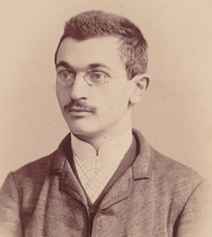
However, the Breslau, 1889 group photograph seems elusive. Has it ever been published?
The tournament was Lasker’s first official appearance, and he won the Hauptturnier after a play-off. An article on page 267 of Deutsches Wochenschach, 10 August 1890 reported on the well-known incident with von Bardeleben in the Berlin, 1890 tournament; during that game Lasker left the tournament hall for a long time. In its discussion of the circumstances, the article also stated that Lasker had to be reprimanded in Breslau for not entirely correct behaviour (“... wegen eines nicht ganz korrekten Verhaltens eine Rüge zugezogen hat”). Is any information available on that alleged incident in Breslau?’
10764. Budapest, 1928 and other footage
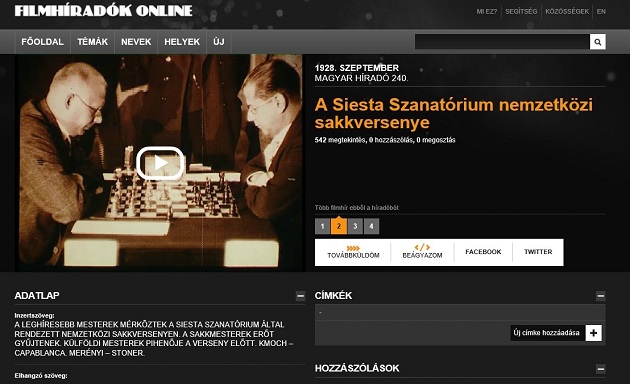
Olimpiu G. Urcan (Singapore) notes that a search for sakk on the Magyar Világhíradók website provides film coverage of Budapest, 1928 (notably featuring Capablanca) ...
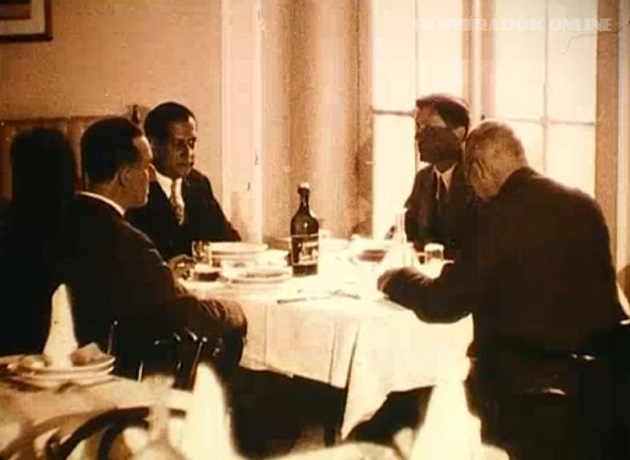
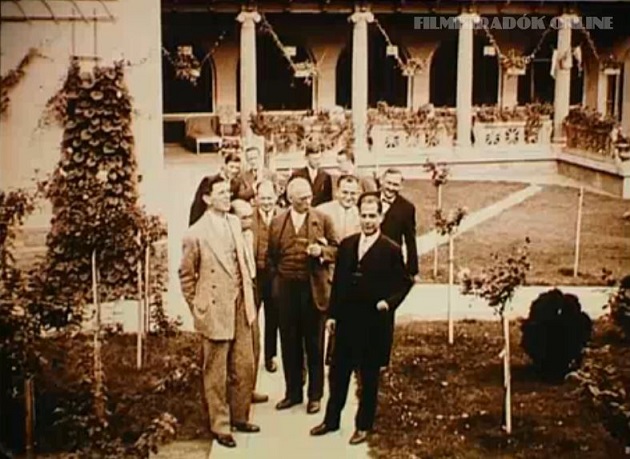
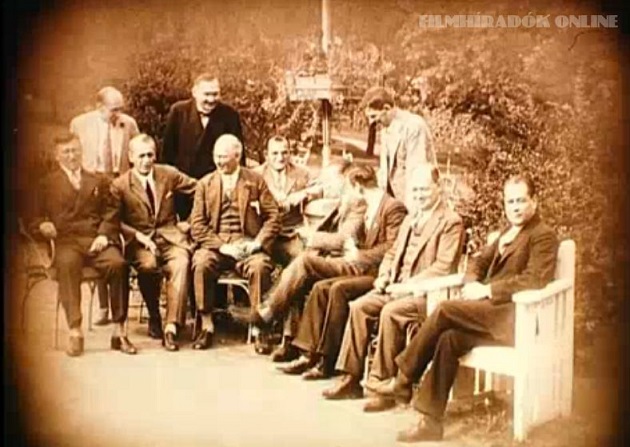
... as well items with footage of Maróczy, Réti, Rubinstein and Tartakower.
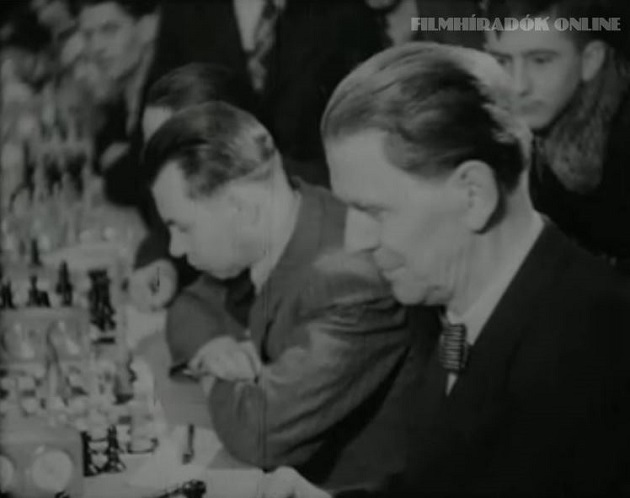

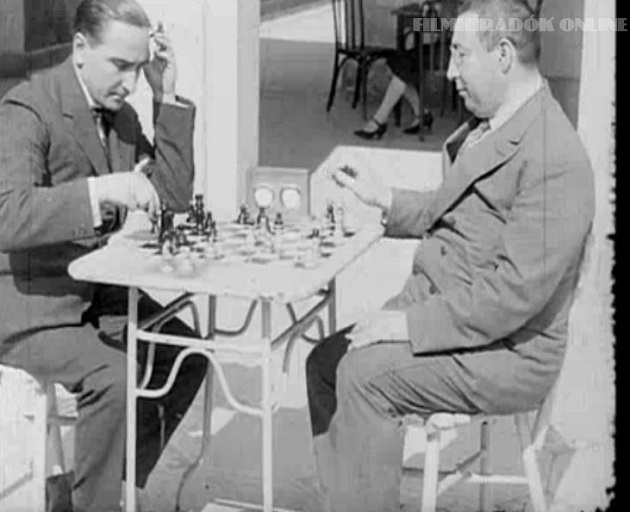
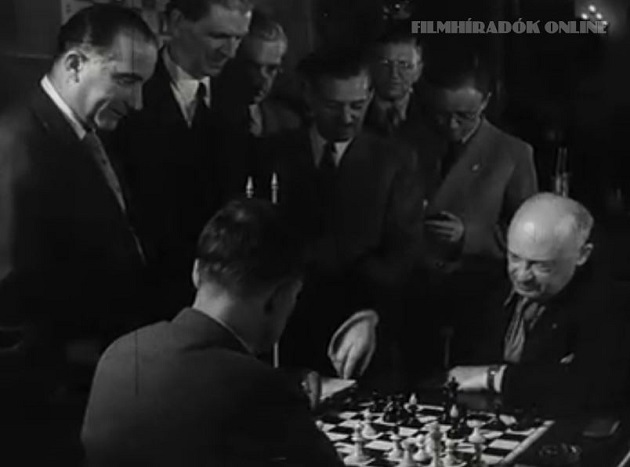
10765. Steinitz’s decline
Rhoda A. Bowles writing in Womanhood, 1901, page 217:
‘In the case of Steinitz, I had it from his own lips that it was the knowledge that his crown of success had passed to a younger generation that mainly contributed to the undoubted bad health from which he suffered for a considerable period prior to his passing away. To lose his pre-eminence meant the loss of his means of livelihood, and his privations were for many years much more acute than was ever publicly made known. He lived to a good age notwithstanding, and if his faculties failed quite at the last it was but a natural end in the circumstances.’
Further comments on Steinitz by Rhoda A. Bowles, from pages 25-26 of The Year-Book of Chess, 1907 by E.A. Michell (London, 1907), are given in Steinitz v von Bardeleben.
10766. A note by Santasiere
This position is from a game between Howard D. Grossman and Donald MacMurray in the New York State Championship, published on page 75 of the July-August 1938 American Chess Bulletin:
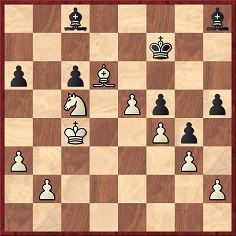
Black played 42...Bg7, which occasioned this idiosyncratic note from Anthony E. Santasiere:
‘Did ever you see two bishops so impotent? – it’s a good thing that Janowsky did not live to see it – you know, he did have a violent temper!’
10767. Blumin v Stephens
A complete game annotated by Santasiere is shown here from pages 108-109 of the November-December 1940 American Chess Bulletin:


1 Nf3 d5 2 d4 Bf5 3 c4 e6 4 Qb3 b6 5 e3 Nf6 6 Ne5 Qd6 7 Nc3 c6 8 Bd2 Be7 9 Be2 O-O 10 Rc1 Nbd7 11 f4 Ne4 12 Nxe4 Bxe4 13 O-O Nxe5 14 fxe5 Qd7 15 Qa4 dxc4 16 Qxc4 Rac8 17 Qa4 Rc7 18 Rf4 Bd5
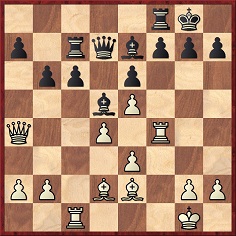
19 e4 b5 20 Qa5 Bxa2 21 d5 exd5 22 Bg4 Qd8 23 Qxa2 dxe4 24 Rd1 Qd4+ 25 Kh1 Qxe5 26 Rdf1 Qd5 27 Qa5 Bd6 28 Rf5 Qd3 29 Rd1 Rd7 30 Rg5 f5 31 Bc3 Qe3 32 Bxf5 Qxg5 33 Bxd7 Qf4 34 Be6+ Kh8
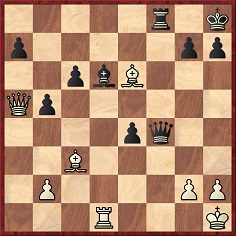
35 Bxg7+ Kxg7 36 Qxa7+ Kh6 37 Qg1 e3 38 Bg4 Be5 39 Bf3 c5 40 Rd5 Bd4 41 Rh5+ Kg7 42 Qb1 h6 43 Rh3 Qf5 44 Qe1
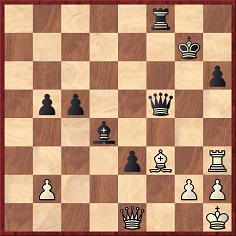
44...Qxh3 45 gxh3 Rxf3 46 Qe2 Rf2 47 Qxb5 e2 48 Qd7+ Kf6 49 Qd8+ Kf5 50 Qc8+ Ke4 51 Qa8+ Kd3 52 Qa6+ Kc2 53 Qg6+ Kxb2 54 Qb6+ Kc2 55 Qg6+ Kc1 56 Qxh6+ Kd1 57 Qh5
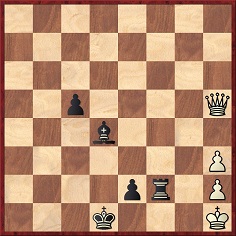
57...Rf1+ 58 Kg2 Rg1+ 59 Kf3 e1(Q) 60 Kf4+ Kd2 61 White resigns.
From page 9 of the January 1941 American Chess Bulletin:
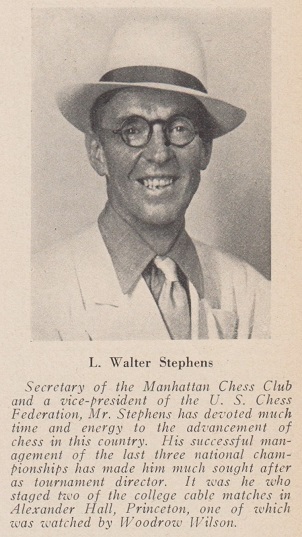
See too page 116 of the May 1941 Chess Review, which had a biographical note on Stephens, a photograph of him and his win over Blumin.
10768. Trompowsky and Alekhine
An addition to the small number of photographs of Octávio Trompowsky is noted by Eduardo Bauzá Mercére (New York, NY, USA), in Xadrez Brasileiro, May 1939, page 63:
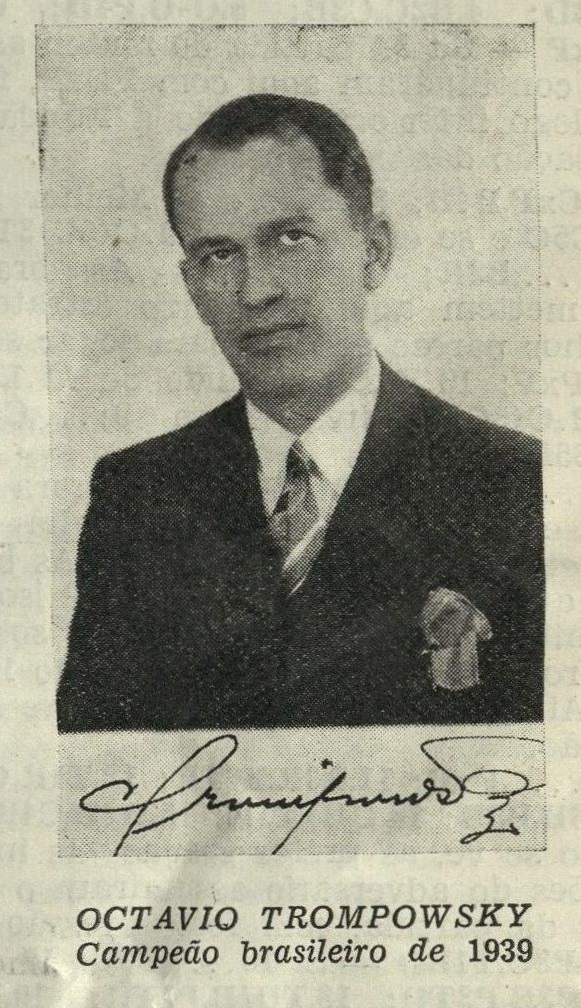
Our correspondent also mentions a photograph of Alekhine on page 83 of the June-July 1939 issue of the Brazilian magazine:

The above are the best-quality scans that we are able to show, with the assistance of the Cleveland Public Library.
Regarding Alekhine v Joaquim Valladão Monteiro, see C.N. 3270 (Chess Facts and Fables, pages 18-19). Further information about Valladão Monteiro is in C.N.s 3884, 3887, 4173 and 5799.
10769. The
English mind
Eduardo Bauzá Mercére has also provided these cuttings from the Observer, 8 January 1939, page 22, and 22 January 1939, page 21:
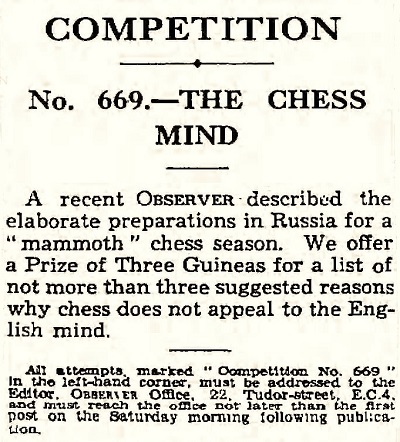

The entries were reproduced, with a few textual discrepancies towards the end, on pages 35-36 of Chess Pieces by Norman Knight (London, 1949):
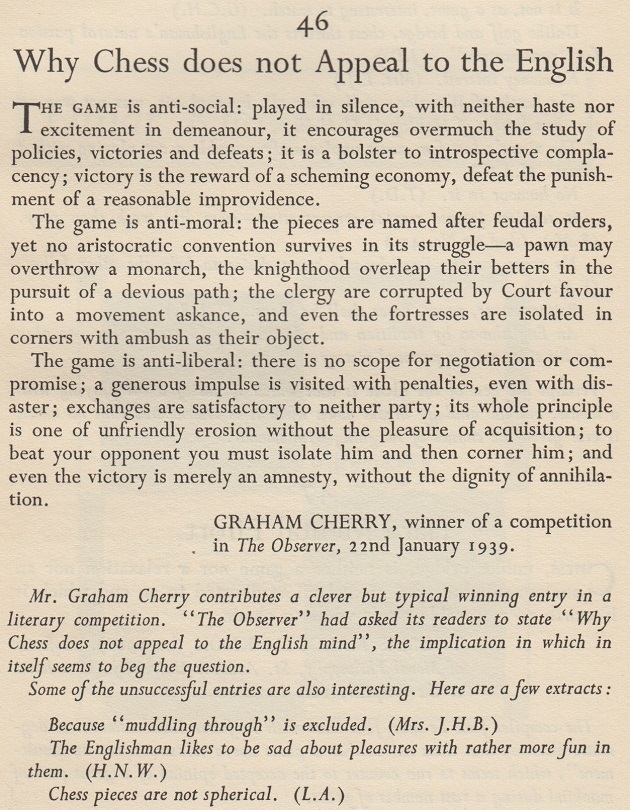
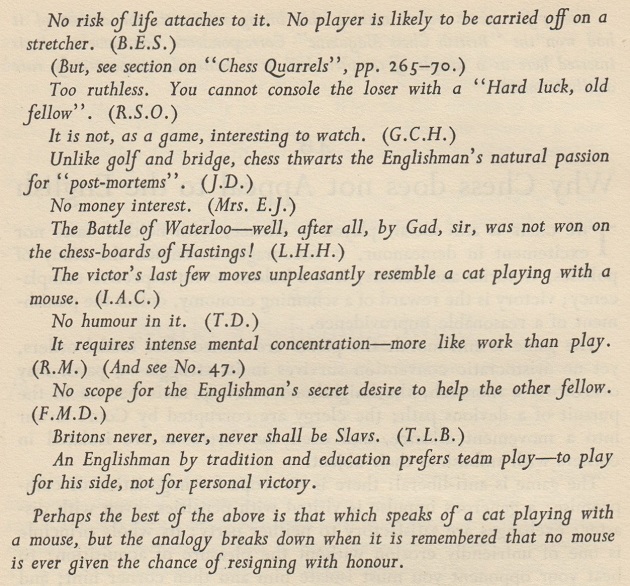
10770. Books on Nigel Short
Sean Robinson (Tacoma, WA, USA) expresses disappointment at the small number, and low quality, of books about Nigel Short, notwithstanding his stature as the only British player to contest a world championship match in the modern era.
There is certainly a significant gap in the market. Although our shelf has monographs on Short published in Argentina, Germany, Hungary, Spain, the United Kingdom and the United States, they are mostly booklets, and only the 79-page volume from Hungary, which covered the period 1990-95, came out after 1993.
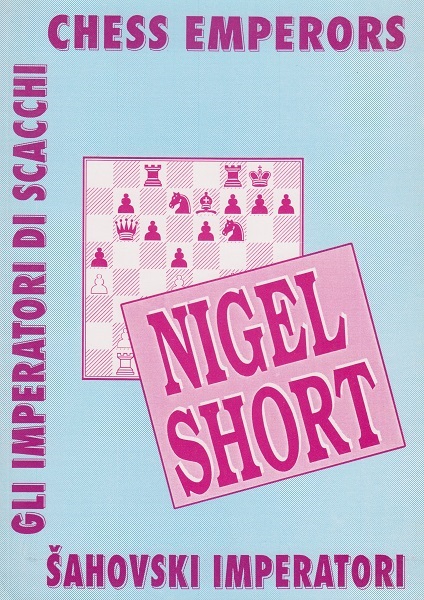
10771. Tarrasch quote (C.N.s 4868, 4877 & 5121)
The conclusion of Fischer v Geller, Skopje, 1967 on page 365 of Fischer’s My 60 Memorable Games (New York, 1969):

The observation by Tarrasch, discussed in C.N.s 4868, 4877 and 5121, was given too in The Chess Wit and Wisdom of W.E. Napier:
‘I knew Dr Tarrasch pleasantly at Monte Carlo, 1902. One day the fates had gone against me, malevolently, I felt, in a game against a man I had counted on beating. I got, by way of spur, this vitamin from the Doctor: “In these tournaments it is never enough to be a connoisseur of chess; one must also play well.”’
Source: the introduction to item 72 of unit one of Napier’s Amenities and Background of Chess-Play (New York, 1934), the inside front cover of the September 1956 Chess Review and page 143 of Paul Morphy and The Golden Age of Chess (New York, 1957 and 1971).
Regarding Tarrasch’s text in Dreihundert Schachpartien (discussed in the earlier C.N. items), a book review on page 51 of the February 1910 BCM gave this translation:
‘I perceived that it did not suffice to be a good player if one did not play well.’
The earliest occurrence of the remark that we can now cite is in L. Hoffer’s biographical article on Tarrasch on pages 354-355 of the Chess Monthly, August 1889:
‘He was, however, unsuccessful in a small tournament at Leipzig in December last, von Bardeleben and Riemann dividing first and second. As Dr Tarrasch told us at Breslau, this contretemps had a salutary effect; and he found “that it is not enough to be a good player, but that one must also play well”.’
10772. Champion of Europe
Alekhine gained the title ‘chess champion of Europe’ by winning the Munich, 1942 tournament. From page 134 of the report in the October 1942 Deutsche Schachzeitung:
‘Das Turnier um die Europäische Meisterschaft ist ausgegangen, wie man es erwartet hat: Aljechin hat neben dem Weltmeistertitel nun auch die Europäische Meisterschaft heimführen können.’
The creation of that title is well documented in the Deutsche Schachzeitung and Deutsche Schachblätter of 1942, but what can be said about a claim that Alekhine had acquired a similar title in the 1920s? Below is a comment by Edgard Colle in a report on Hastings, 1925-26 on page 9 of the January 1926 issue of L’Echiquier:
‘Il est clair qu’avant le commencement du tournoi, la victoire d’Alekhine ne faisait aucun doute – tout au plus pouvait-on se demander si le sympathique champion d’Europe accorderait une ou deux nullités à ses adversaires, parmi lesquels seul le Dr. Vidmar était de taille à l’inquiéter.’
10773. Under-rated
An observation by A.E. Santasiere on page 65 of the July-August 1940 American Chess Bulletin:
‘Shainswit is one of America’s strongest players – consistently under-rated.’
George Shainswit’s appearance on the front cover of the August-September 1943 Chess Review:
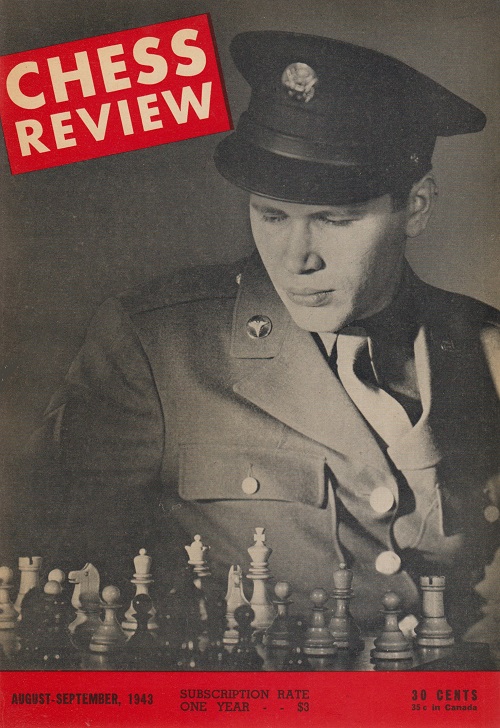
10774. Books on Nigel Short (C.N. 10770)
Michael Allard (Bowie, MD, USA) notes a book with extensive treatment of the games of Nigel Short and Jan Timman: The Way to Linares’ Summit by Alexander Kulagin (Würzburg, 1993).
10775. Reshevsky in simultaneous play
From a report entitled ‘Rzeschewski at Hampstead’ on page 47 of the Chess Amateur, November 1920:
‘When thinking over his moves Rzeschewski whistles softly to himself and rapidly twirls a pawn in his fingers, even pressing it into his cheek in more absorbed moments. He does not complete his round quickly, for he likes to make several moves at each board, and waits for the replies, sometimes turning back to a board where the situation is especially exciting. When he has an advantage in the endgame, he moves at a great rate, but in emerging from the opening into the middle game he is slow. The most noticeable general point in his strategy is the employment of the KB on the diagonal KR1 to QR8, either by the fianchetto development or by B-K2, followed by B-B3.’
10776. Janowsky and Maas
Page 70 of The Big Book of World Chess Championships by A. Schulz (Alkmaar, 2016) states that Dawid Janowsky ‘died, only 56 years old, alone and completely penniless’.
At the time of his death, aged 58, Janowsky’s circumstances were indeed dire, but the financial support of A.J. Maas is not to be forgotten. From page 553 of L’Echiquier, January 1927:
‘Le maître Janowski vient de mourir, samedi, 15 janvier, à la clinique de Hyères où, grâce à la générosité de M. A.J. Maas, le grand maître a pu être entouré de tous les soins que nécessitait une maladie incurable.’
For photographs of Maas, see C.N. 3606 and (a group picture also featuring Janowsky) C.N. 4023.
John Keeble wrote an obituary of Maas on pages 413-414 of the October 1933 BCM:
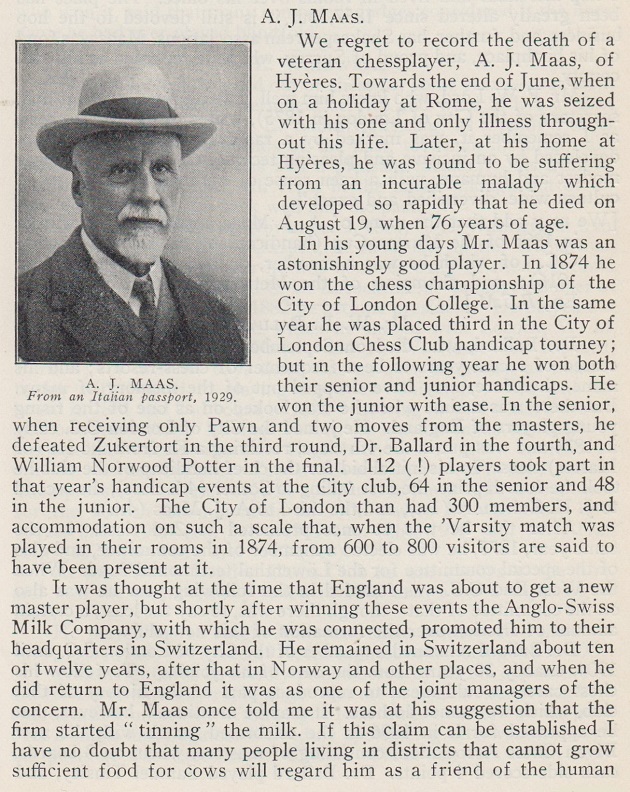
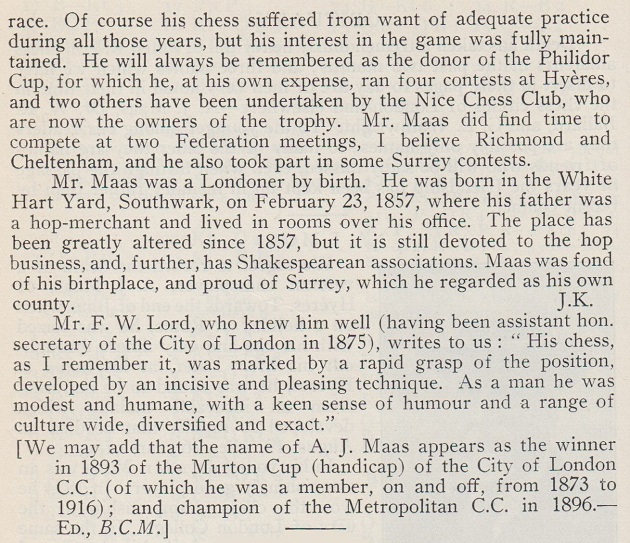
10777. Two endgames
These two endgame positions will be discussed in a future item:
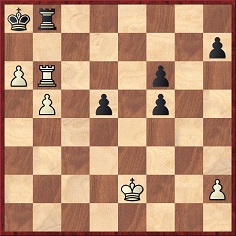
White to move
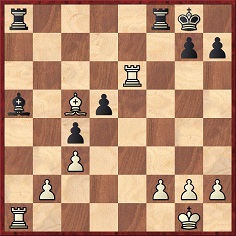
Black to move.
10778. Tempi (C.N. 10751)
Regarding suggestions that the value of a pawn may be three tempi, Thomas Niessen (Aachen, Germany) draws attention to the following, on page 137 of the Deutsche Schachzeitung, May 1866:
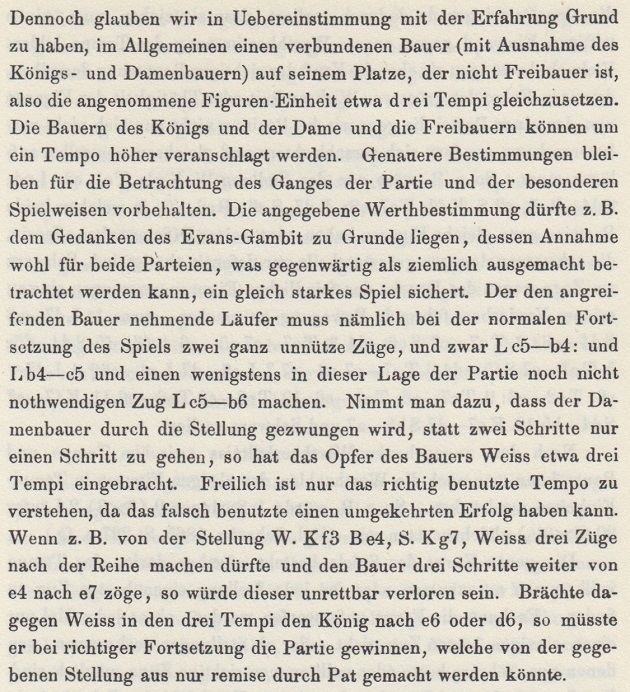
This comes from an article entitled ‘Synthetische Grundlage zur Theorie des Schach’ by Eugen von Schmidt.
10779. Tenner v Feldman
Oscar Tenner – J. Feldman
Manhattan Chess Club Championship, New York, 1939-40
French Defence
1 e4 e6 2 d4 d5 3 Nc3 Nf6 4 Bd3 c5 5 Nf3 Nc6 6 Be3 cxd4 7 Nxd4 e5 8 Nxc6 bxc6 9 exd5 Nxd5 10 Qf3 Bb4 11 O-O O-O 12 Qe4 f5 13 Qxe5 Re8 14 Qd4 Bd6 15 Nxd5 Be5 16 Qa4 cxd5 17 Bb5 Re6 18 Rad1 Bb7 19 c3 Rg6
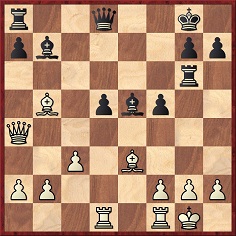
20 f4 d4 21 Rf2 Qh4 22 fxe5 Qh3
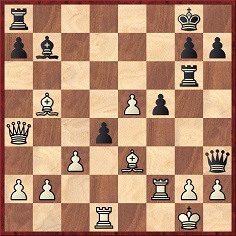
23 Bg5 Rxg5 24 Bc6 Bxc6 25 Qxc6 Rf8 26 Qe6+ Kh8 27 Qe7 Resigns.
Sources: American Chess Bulletin, March-April 1940, page 48, and Chess Review, April 1940, page 58.
10780. Ortueta v Sanz
Page 586 of L’Echiquier, 8 August 1934:
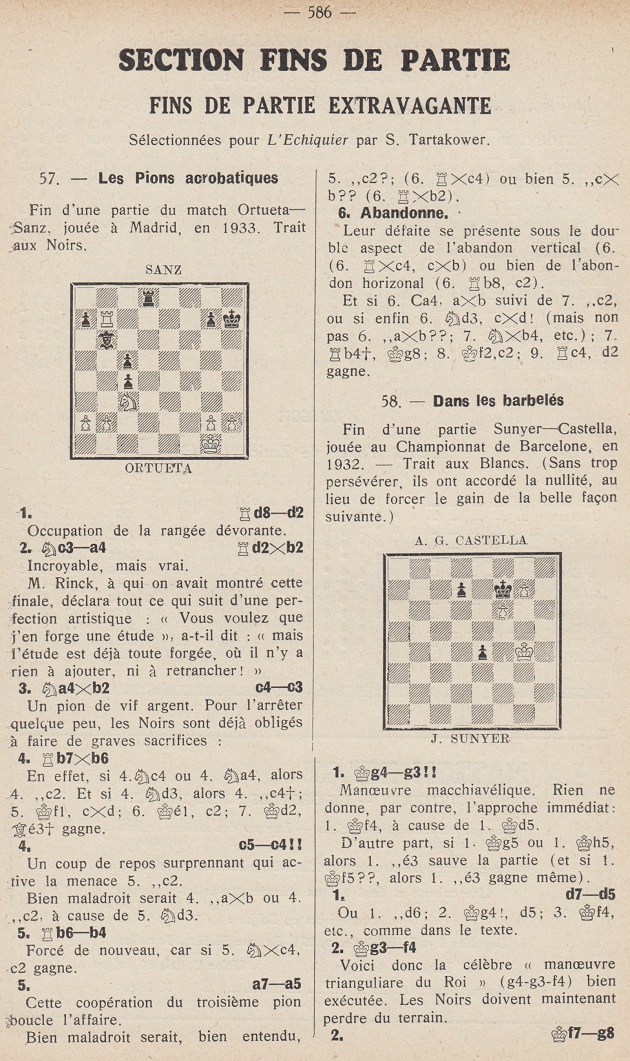
On the Ortueta v Sanz mystery Alan McGowan (Waterloo, Canada) writes:
‘Page 200 of the July 1933 Deutsche Schachzeitung gave the result of the tournament in Madrid in which the Ortueta v Sanz game may have been played:
If that was indeed the tournament, it is remarkable if the full game was not published earlier than 1936.
The 11 April 1934 edition of the Neues Wiener Journal, page 7, referred to involvement by the police after a report of Ored Karlin’s disappearance from a Budapest hotel:
The 13 January 1935 edition of the Estonian publication Esmaspäev, page 8, discussed the endgame:
As with the Tagesbote article (C.N. 8830), it appears that Karlin suggested that the position was from one of his own games. Soon afterwards, however, the writer noticed the feature on page 356 of the December 1934 Wiener Schachzeitung which credited it to the Ortueta-Sanz game.
The position in the Tagesbote column of 14 April 1934 shows white pawns on a2, b2, g2, f3 and e4 (no pawn on h2). L’Echiquier, 8 August 1934, page 586, the Deutsche Schachblätter, 15 August 1934, page 249, and the Wiener Schachzeitung, December 1934, page 356, had white pawns at a2, b2, g2 and h2, as did the above column in Esmaspäev.
The story about Karlin disappearing from the Budapest hotel and the two newspaper reports suggesting that he claimed the endgame as his own seem to raise doubts about his character. However, that has to be set against comments made by Anders Wigren to Tim Krabbé in item 396 in the latter’s Open Chess Diary.’
10781. The Rice Gambit (C.N. 6857)
Concerning the Rice Gambit match between Emanuel Lasker and Carl Schlechter, C.N. 6857 showed a report in the Deutsche Schachzeitung that the result was +3 –0 =2 in favour of Schlechter.
Now, Hans-Georg Kleinhenz (Munich, Germany) points out that a column by Schlechter on page 1055 of the Allgemeine Sport-Zeitung, 23 August 1908 stated that he won the match +4 –0 =2:
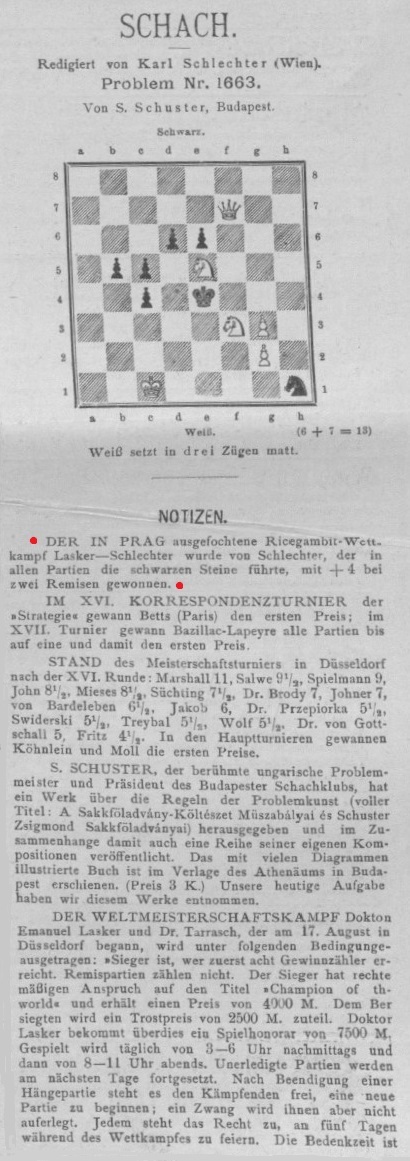
Our correspondent adds that a complete run of Schlechter’s column is available online.
10782. Ortueta v Sanz (C.N. 10780)
From Christian Sánchez (Rosario, Argentina):
‘The international tournament in Madrid in 1933 was played from 22 to 28 May in the Casino Militar (Centro Cultural del Ejército y de la Armada). The participants were Ored Karlin (Sweden), Willy Kocher (Switzerland) and the Spanish players Vicente Almirall (the winner), Lotario Añón, Alfonso Cadenas, Martín de Ortueta, José Sanz and Ramón Tramoyeres. Sources: the Madrid newspapers Luz, 24 May 1933, page 14, El Sol, 24 May 1933, page 8, and subsequent issues. The main prizes were: 500 pesetas, 300 pesetas and 200 pesetas. The event was covered by the local press and particularly Luz and El Sol. The Luz chess columnist was José Sanz himself, and the reporter in El Sol was Pedro Sánchez de Neyra y Castro, Marquis of Casa Alta, who was the arbiter of the tournament.
No incident occurred until the last round. Sanz simply wrote about his game: “Sanz ½ Karlin ½. Interesting theoretical variation in the Cambridge Springs. White needs a win to take second place, but all the variations lead to a draw.” Source: Luz, 30 May 1933, page 14. However, on page 8 of El Sol, 1 June 1933 Casa Alta inserted a position (shown below) from that Sanz-Karlin encounter, and wrote that Karlin would have a won game after ...h3 but played differently and only drew. Insinuating some kind of collusion, Casa Alta reported that the next day he even confronted Karlin and asked for an explanation. Karlin replied that he “had a headache”.
Sanz answered the accusation (that “the Swedish master gave away the draw”) in his column by noting that Karlin had previously offered a draw twice and that he had refused. The feud continued over the following weeks.
Meanwhile, two matches with a purse were arranged, also at the Centro Cultural del Ejército y de la Armada: Karlin v Almirall and Ortueta v Sanz. In El Sol of 4 June 1933, page 10 Casa Alta replied to Sanz’s response and gave the latest scores in the two matches. For Karlin v Almirall he stated that the first game was won by Karlin and the second was drawn; the third game was being played on 3 June. The score of the Ortueta v Sanz match was reported as a victory by Ortueta in the first game, followed by two draws. The former contest ended in a tie 2½-2½, as stated by ABC on 7 June 1933, El Sol on 8 June 1933, and Luz on 9 June 1933. The dates of play were probably 1-5 June.
In El Sol, 11 June 1933, page 10 Casa Alta presented the Ortueta-Sanz ending without any moves (adding that this win by Sanz was followed by a victory by Ortueta, the last game of the match so far), and he also continued his argument with Sanz:
Karlin left Madrid on 10 June for Saragossa, where, on 11 June, he played Ramón Rey Ardid. Sources: El Sol, 13 June 1933, page 6, and El Mundo Deportivo, 18 June 1933, page 3.
In El Sol, 18 June 1933, page 10 Casa Alta reported that the Ortueta-Sanz match had been suspended when the score was 2½-1½ and gave a game in which Ortueta (Black) won in 36 moves. There is a discrepancy in the match score as given in Casa Alta’s columns.
Sanz presented the finish to his famous game, starting some moves before the combination and showing a knight on b6 instead of a bishop, in Luz, 26 June 1933, page 14:
Conclusions:
The famous combination occurred in an actual game between Ortueta and Sanz. It was the penultimate game in a public match, played in the first week of June 1933 at a renowned club in Madrid.
On 11 June 1933 Casa Alta published a key position preceding the combination, either because he was a witness or because he had a reliable source. Although the issue of the combination’s authenticity arose later, Casa Alta did not question it, notwithstanding the fact that he was in the midst of a feud with the winner, Sanz.
- Karlin was playing (a match against Almirall) at the same place and at the same time.’
10783. Two endgames (C.N. 10777)

White to move
On page 137 of Womanhood, 1903 Rhoda A. Bowles wrote:
‘In passing through Paris on his return journey from Vienna, Mr Pillsbury naturally looked in at the Café [de la] Régence, where all French chessplayers meet. He saw a game given up as a draw by Taubenhaus, who was conceding the odds of a knight to an amateur; but the eagle eye of Pillsbury caught the glimpse of a win for White and he “dug it out” ...’
Page 207 recorded that W.B. Dixon and Alfred Gunsberg had sent the solution: 1 Rxb8+ Kxb8 2 b6 f4 3 Kf3 f5 4 Kxf4 d4 5 Ke5 d3 6 Kd6 d2 7 a7+ Kb7 8 a8(Q)+ Kxa8 9 Kc7 d1(Q) 10 b7+ Ka7 11 b8(Q)+ Ka6 12 Qb6 mate.
The second position in C.N. 10777 is from the game Réti v L. Steiner, Berlin, 1928:

Black played 26...Bxc3 and won, but an even better line was 26...Bb4, as André Chéron pointed out on page 965 of L’Echiquier, July 1928:
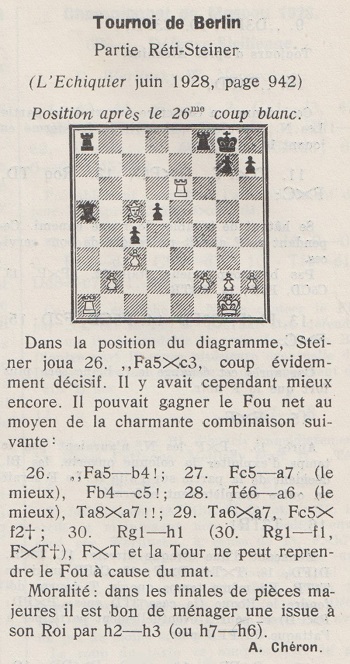
26...Bb4 was also given on pages 219-220 of the July 1928 Deutsche Schachzeitung:
‘Wie Meister Grünfeld mitteilt, fand B. Hönlinger, daß Steiner in der abgebildeten Stellung mit 26...La5-b4 (statt Lc3:) noch schneller entscheiden konnte, da dieser Zug eine Figur gewinnt ...’
10784. Peter Winston
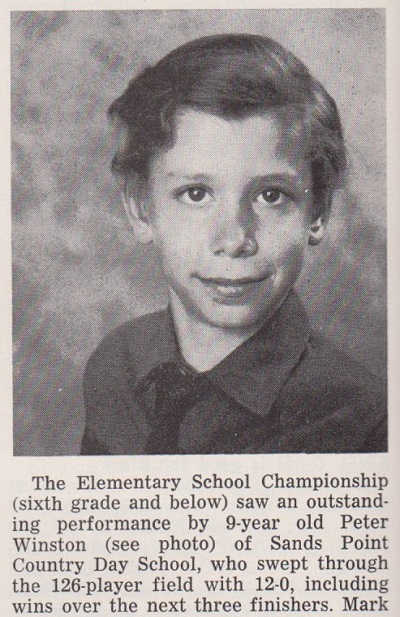
Source: Chess Life, April 1968, page 140.
| First column | << previous | Archives [164] | next >> | Current column |
Copyright: Edward Winter. All rights reserved.

